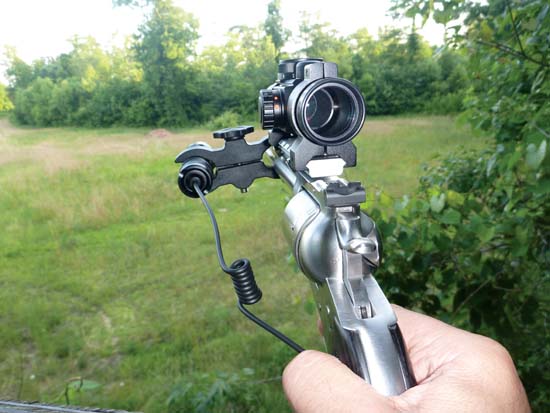

barrel of a Ruger Bisley Hunter.
Big-bore revolver scopes, red-dot sights and open sights are discussed in this article on handgun hunting.
You have made the decision to hunt with your new big-bore revolver, and now you are facing the decision of choosing a sighting system for this short-barreled firearm. Or maybe you will only be punching paper and not hunting. What is the best system available? That depends. There are a number of factors that determine what is best for you.
The handgun hunter and recreational shooter should ask themselves a number of questions, in order to make an educated determination and help narrow down the hundreds of choices out there.
Are you hunting over bait from a stand? If so, how long of a shot do you expect and what is the maximum distance you could end up ultimately shooting? Will you be shooting off a rest (for maximum stability)?
Are you hunting with dogs? How good is your vision? Another thing to consider is recoil and making sure the system you choose can withstand the considerable abuse generated by a high-powered handgun.
Sighting System 1: Scopes
There are a number of quality scopes produced specifically for handguns today, such as those offered by Burris and Leupold. What sets them apart from other firearms scopes is that they will have a long eye relief, enabling their effective use on a firearm that is held at arms’ length.

Using a scope on a handgun requires some getting used to. All the shakes and wobbles we experience when shooting offhand are exaggerated when peering through a scope, particularly when using a variable scope set to a high magnification. With a handgun, you don’t have the benefit of whole-body support for the firearm. Thus, the movement of the firearm is increased.
Because of the long eye relief inherent in handgun scopes, the light gathering capability of the exit pupil is compromised. Therefore, some of the advantages gained by using a scope on a rifle don’t quite translate over to a handgun scope. These are simply physical limitations that are not the fault of design or manufacture, but rather the location of the scope relative to the shooter’s eye.
Scoped handguns are best used with a solid rest. For hunting applications, this makes them nearly optimal for use from a stand or blind over bait, where you’ll have the rail of your stand or even shooting sticks to use.
Scopes also offer, of course, the added benefit of magnification, allowing the hunter to better assess and judge the animal in their sights, and the ability to shoot at longer ranges more accurately. Likewise, the target shooter should be able to shoot more accurately with a scope on a handgun, as the sighting system is more precise from an aiming standpoint.
All that being said, personally, I don’t care for scopes on big-bore revolvers, mostly because they are difficult to use in a hurry, i.e., it’s difficult to quickly acquire a solid and thorough sight picture. Where you have the luxury of glassing an area and carefully picking your shot, scopes are fine.
But, to me, this is a very limited option that truly has specific times and places for use. If a scope is something you choose for your handgun, check with the manufacturer and make sure that the scope you’re considering is made specifically for or is compatible with handgun use and can handle the recoil from big-bores in particular.
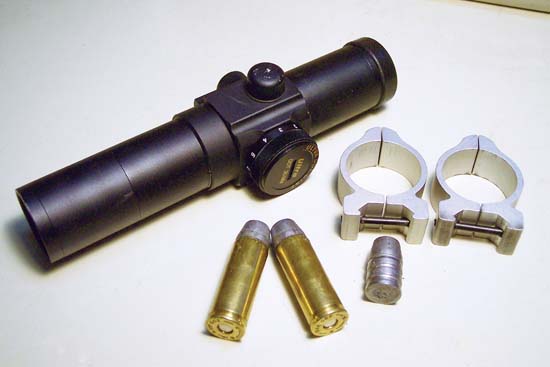
Sighting System 2: Red Dot Sights
This type of sighting system generally offers no magnification, but instead superimpose an illuminated red dot on the intended target. This is a personal favorite of mine for most hunting and shooting applications. The red dot can be adjusted for brightness to compensate for changing light conditions in the field or out on the range, and it is probably the best solution for low-light hunting situations.
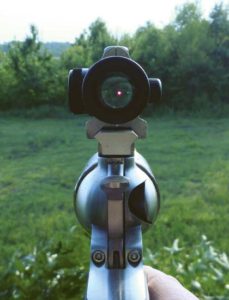
Best of all, it is very easy to acquire in a hurry, a factor that’s enhanced when you choose a model that features an adjustable dot size. This last option is also handy if you’re shooting different sized game, where a large dot can cover up too much of the vital area and actually inhibit accuracy. I find the red-dot sights most advantageous in low-light conditions, where the black crosshairs of a regular scope may be hard to see.
There are essentially two types of red dot sights. The first is a tube type that resembles a scope and is adjusted and mounted in the same manner. The second are the holographic sights, which project a red dot on a small screen.
The holographic-type sight is quite compact and may not add more than a few ounces to your shooting rig. Where this second type is weak is during inclement weather, as it may be difficult to keep the screen clean and procure an unobstructed view of your target.
Red dot-type sights in general are light in weight and don’t change the balance of your gun in any significant way. As with a standard scope, be sure to speak to the manufacturer prior to spending your money, to make certain the red dot you choose is up to the task of withstanding the recoil of your handgun.
In any case, a good warranty goes a long way towards customer confidence. The company known as Ultradot produces a whole line of economical and rugged red dot-type sights that come with a lifetime warranty. I am a big fan of this maker’s products for a number of reasons, but mainly for their reliability.
I have had an Ultradot 30—it has a 30mm tube diameter, hence the designation—on a number of my heavy recoiling revolvers and can report that this sight has exceeded my expectations by a dozen miles. Thousands of full-tilt .475 Linebaugh and .500 JRH rounds have truly tested the integrity of that Ultradot.
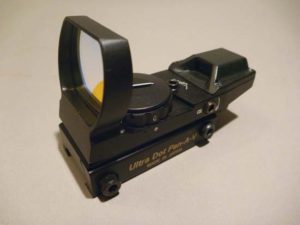
The poor unit now resides on my ultra-abusive, lightweight Ruger Super Redhawk in .500 Linebaugh. I have not been kind to my Ultradot, but, like a loyal dog, it keeps coming back wagging its tail. See the sidebar at the end of this chapter for more insight on this optic.
The only drawback with any red dot-type sight is that battery failure can leave you high and dry when you can least afford it (think large, toothy animal with bad intent bearing down on you, or the trophy buck of a lifetime striking a pose for you).
Remember to always carry a spare battery and the tools (in this case a quarter!) necessary to change it in the field. From supported and unsupported shooting positions, the red dot shines.
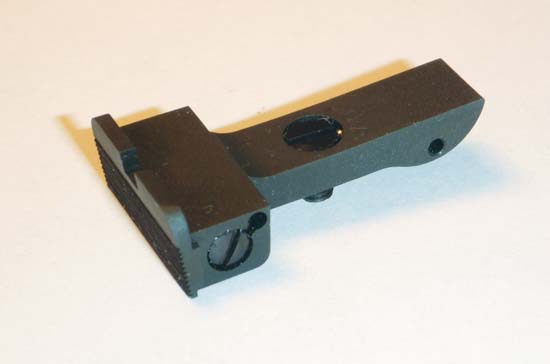
Sighting System 3: Open Iron Sights
Here’s one for the purists among us big-bore revolver fanatics. Virtually every hunting or target revolver comes with a set of adjustable iron sights up top (okay, there are a couple that come with fixed sights, like the Ruger Vaquero), and they work well, as long as you have adequate light.
They are quick to acquire, but, maybe most importantly, since the user isn’t peering through a tube, they then have a full view of their surroundings. Why is this important? Just ask those who hunt bear or wild hogs with dogs why it’s crucial to see all that is going on around them in the ensuing chaos of a hunt with hounds. The handgun hunter must be able to respond quickly, assess the situation, pick their shot, and make absolutely certain that no dogs are in the way. Open sights, in this type of situation, have no equal.
One of the other greatest advantages open sights enjoy is their resistance to recoil—plus, they have no glass to break or batteries to die. Ultra reliability is another bonus. The only real limitation to using open iron sights is the shooter’s vision and ability to line up the front and rear sights on the target. You may find that the older you get, the better you were.
In my humble opinion, the best adjustable rear sight available on the aftermarket is manufactured by Hamilton Bowen of Bowen Classic Arms. Those unfamiliar with Bowen’s work skipped over the fourth chapter of this book! His are, by far, the best adjustable rear sight available for a revolver. They are precise, easy to adjust, and well-made.
Conclusion
Whatever you choose, you need to practice enough to completely familiarize yourself with the sighting system. Some sights take some getting used to but, once you get there, their use should become second nature.
This article is an excerpt from Big Bore Revolvers.

Next Step: Get your FREE Printable Target Pack
Enhance your shooting precision with our 62 MOA Targets, perfect for rifles and handguns. Crafted in collaboration with Storm Tactical for accuracy and versatility.
Subscribe to the Gun Digest email newsletter and get your downloadable target pack sent straight to your inbox. Stay updated with the latest firearms info in the industry.

![Best Concealed Carry Guns In 2025 [Field Tested] Wilson Combat EDC X9S 1](https://gundigest.com/wp-content/uploads/Wilson-Combat-EDC-X9S-1-324x160.jpg)


![Best 9mm Carbine: Affordable PCCs [Tested] Ruger Carbine Shooting](https://gundigest.com/wp-content/uploads/Ruger-Carbine-Shooting-100x70.jpg)
![Best AR-15: Top Options Available Today [Field Tested] Harrington and Richardson PSA XM177E2 feature](https://gundigest.com/wp-content/uploads/Harrington-and-Richardson-PSA-XM177E2-feature-100x70.jpg)
